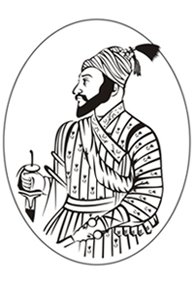(The route taken by Shivaji after his flight from confinement at Agra, 18th August 1666)
Till today no one knows the exact route which Shivaji took for reaching Rajgarh after a successful and sensational escape through six rings of guards as shown in the adjoining sketch. Rajgarh is 670 miles from Agra in a straight line but he must have covered nearly a thousand miles in reaching the safety of his home. The Akhabarat of 4th November 1666 mentions the news received from the Deccan that Shivaji and his son had reached Rajgarh.
The accompanying diagram shows the routes which different sources suggest Shivaji took in returning safely to Maharashtra.
Route No.I shown in Red is the one suggested by Sir Jadunath Sarkar. According to him, from Agra Shivaji first went in the opposite direction to Mathura to confuse his pursuers. Here he left his son (Shambhaji) under the care of trusted Maratha priests, reached Allahabad and then passing through Gondwana and the less inhabited areas of Golkonda and Bijapur, reached Rajgarh (12th September 1666) to the great surprise and happiness of Jija Bai, his mother.
Route No.II shown in Blue incorporates the information from the Marathi sources and is merely an extension of the first. According to it Shivaji also visited Varanasi, Gaya and Puri on the way and thereafter the route which he took passed through territories of Golkonda and Bijapur and ended at Rajgarh.
Route No.III shown in Green seems, the more likely route taken by Shivaji. It passed through Mathura, Dausa, Shahpura, Banswara, Rajpipla and Saler. About fifteen years later (1681 AD), when Durgadas Rathor escorted Prince Akbar (rebel son of Aurangzeb), to Shambhaji, he had taken the route which passed through Banswara, "Bharvargar Ghat" on the Narmada, Rajpipla and reached Saler on Jyestha Vadi 5, V.S. 1737 (29 April 1681) in "Shambhaji's mulak". This was the safest and the shortest route, the only dangerous area being that around Ahmedabad.
This route was safest as travelling through Rajasthan, even in the disguise of a Bairagi was more safe than covering more than 462 km. – the distance from Mathura to Allahabad in a straight line – and passing through three Mughal provinces, and then through none too friendly Golkonda and Bijapur States, to reach Rajgad. Shivaji had immense goodwill and respect for him among the Rajputs and who knows what arrangements Kunwar Ram Singh had made to facilitate Shivaji's escape and his safe return to his home land, to keep the 'tek' or pledge of his father, about which he was extremely sensitive, as the contemporary letters of Parkaldas from Agra amply show.
Till today no one knows the exact route which Shivaji took for reaching Rajgarh after a successful and sensational escape through six rings of guards as shown in the adjoining sketch. Rajgarh is 670 miles from Agra in a straight line but he must have covered nearly a thousand miles in reaching the safety of his home. The Akhabarat of 4th November 1666 mentions the news received from the Deccan that Shivaji and his son had reached Rajgarh.
The accompanying diagram shows the routes which different sources suggest Shivaji took in returning safely to Maharashtra.
Route No.I shown in Red is the one suggested by Sir Jadunath Sarkar. According to him, from Agra Shivaji first went in the opposite direction to Mathura to confuse his pursuers. Here he left his son (Shambhaji) under the care of trusted Maratha priests, reached Allahabad and then passing through Gondwana and the less inhabited areas of Golkonda and Bijapur, reached Rajgarh (12th September 1666) to the great surprise and happiness of Jija Bai, his mother.
Route No.II shown in Blue incorporates the information from the Marathi sources and is merely an extension of the first. According to it Shivaji also visited Varanasi, Gaya and Puri on the way and thereafter the route which he took passed through territories of Golkonda and Bijapur and ended at Rajgarh.
Route No.III shown in Green seems, the more likely route taken by Shivaji. It passed through Mathura, Dausa, Shahpura, Banswara, Rajpipla and Saler. About fifteen years later (1681 AD), when Durgadas Rathor escorted Prince Akbar (rebel son of Aurangzeb), to Shambhaji, he had taken the route which passed through Banswara, "Bharvargar Ghat" on the Narmada, Rajpipla and reached Saler on Jyestha Vadi 5, V.S. 1737 (29 April 1681) in "Shambhaji's mulak". This was the safest and the shortest route, the only dangerous area being that around Ahmedabad.
This route was safest as travelling through Rajasthan, even in the disguise of a Bairagi was more safe than covering more than 462 km. – the distance from Mathura to Allahabad in a straight line – and passing through three Mughal provinces, and then through none too friendly Golkonda and Bijapur States, to reach Rajgad. Shivaji had immense goodwill and respect for him among the Rajputs and who knows what arrangements Kunwar Ram Singh had made to facilitate Shivaji's escape and his safe return to his home land, to keep the 'tek' or pledge of his father, about which he was extremely sensitive, as the contemporary letters of Parkaldas from Agra amply show.

